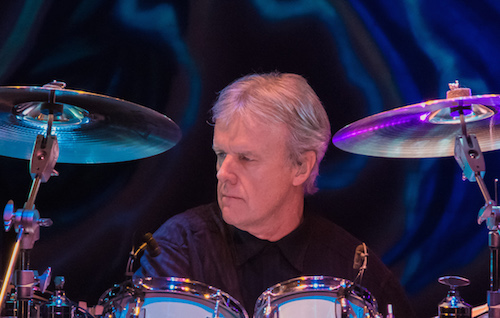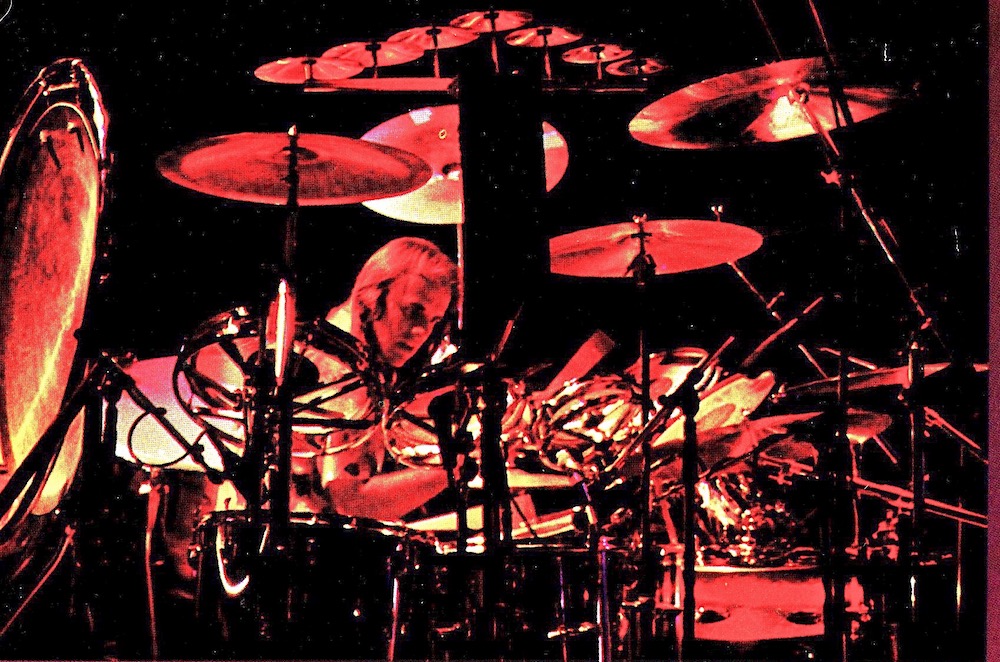Phil Ehart of Kansas on the Roots of Leftoverture and Point of Know Return, and the New Prelude Implicit Album

by Will Romano
Atypical instrumentation, ambitious compositions, and ubiquitous Top-40 hits like “Point of Know Return” and “Dust in the Wind” have made Kansas one of America’s most enduring progressive rock bands. Having survived various lineup reconfigurations throughout its forty-plus year history, the band continues to record and tour, retaining support from longtime fans while igniting enthusiasm in younger generations of listeners.
As they say, wait around long enough and every pop culture trend comes back into vogue. Still, Kansas is hip and chic in ways no one—not even bandleader, guiding light, and drummer Phil Ehart—could have envisioned in the 1970s. Consider the FM radio staple “Carry on Wayward Son” from the 1976 multi-platinum breakthrough effort Leftoverture. Seventeen-year-old Josh West, a contestant on NBC’s The Voice this year, wowed the celebrity judges when he belted out the tune. The classic-rock anthem has also been claimed as the unofficial theme song of the CW Television Network’s popular paranormal series Supernatural. If that weren’t enough, Kansas skillfully navigated the dynamics of the piece—live and in the flesh—during a surprise appearance at the 2017 Comic-Con in San Diego. (Check out the brand-new release Leftoverture: Live & Beyond.)
MD tracked down Ehart to discuss Kansas’s resurgence, the different aspects of his drumming style, and the details of their recent studio album of all-new material, The Prelude Implicit, the band’s first in sixteen years. Advertisement
MD: Kansas has been on the road performing, in its entirety, the album Leftoverture. Interestingly, the setlist for your 2015 tour included a lot of material from that record.
Phil: It was the fortieth anniversary of the record coming on, and it’s still around right now. We’re going to be finishing the year with the Leftoverture shows. We were a bit reticent about playing Leftoverture, because there were some songs on there we never performed live. Going back and listening, we said, “Yeah, it works great.”
MD: What do you perceive is the difference between the 1970s Phil Ehart and 21st Century one?
Phil: We were so much younger and played so much faster. The music seemed like it was moving at a million miles a minute. As you get older you don’t quite play as fast.
MD: Playing the whole of Leftoverture and songs from The Prelude Implicit is a good way to acclimate young listeners and reintroduce longtime fans to your music. Can you speak to the support you’ve gotten?
Phil: The new album was received so well by people, including avid Kansas fans. That meant a lot to us and gave us the confidence to take it out on the road and play some of it each night. Kansas’s resurgence is unexpected. Doing the documentary [Miracles Out of Nowhere, 2015] and having it played every week on Palladia [now MTV Live], I think it lit a fuse for a lot of people who had forgotten about our music. Advertisement
Steve [Walsh, longtime lead vocalist] retiring set us back, and it was painful to watch him lose his voice. Ronnie [Platt] came on as a singer, David Manion is our keyboardist, and Zak [Rizvi, guitarist], who was our producer for the new album, is now part of the band, which was totally unexpected. We had lost a lot of the vocal abilities, because once Steve started to slide—it wasn’t any secret, he knew it—it was just a matter of time. Ronnie has done a great job on vocals, and David has done a great job on keyboards, bringing back that B-3 just as it was for the original band. Now with Zak, along with Rich [Williams], we have our two guitarists again. We have four good vocalists for all those vocal harmonies, just as we did on those early records.
It’s a good time for the band right now, and we’ll start on a new album at the beginning of 2018. And just as we did for Leftoverture we’ll have parts of the new album tied to Point of Know Return when we tour.
MD: Let’s shift to your playing style. On earlier Kansas albums you often grooved via the use of ghost notes. Can you discuss how this technique developed?
Phil: I’ve never taken any lessons and I don’t know how to read music. I’m a hundred percent self-taught. When people ask me about specific techniques and how things I play are done, I have no idea. [laughs] I don’t play much from the brain. I play much more from the heart. The groove is very important; you’re correct. I do concentrate on that. I’m a big Buddy Rich fan—not that I could ever do his laundry. I would watch how he would work his left hand on that snare drum. I’d make feeble attempts to drag my left stick across the snare. It became a kind of technique. It fit with the music we were doing at the time, and it helped fill space. When I was learning how to play drums I was living in the Philippines or in Japan or on an airbase in Great Falls, Montana. All I could do is turn on the radio and tap on a snare drum. By the time I was playing in Kansas I was twenty. Advertisement
MD: Your father was in the service?
Phil: He was, he was an Air Force officer. We picked up and moved to some place obscure every two years of my life.
MD: How does Kansas, the state, fit into your background?
Phil: I was born in Kansas, but as soon as I was born we took off. I went to England for a while, played there, and came back and put the original band together, the band everyone knows. My dad ended up retiring in Kansas.
MD: You’ve admitted that you were pretty much alone in London. It was you, your apartment, and a transistor radio.
Phil: That was the transistor radio my dad gave me before I had left. About six o’clock at night the electricity would shut off because I couldn’t afford to keep it on. The electricity was coin-operated. I would have to sit in my apartment by myself, in the dark—a one-bedroom flat—listening to the radio. I was thinking, “What am I doing here?”
After my visa ran out, I went back home. I learned a lot about life and knew exactly how badly I wanted to do this [play music for a living]. There was never any doubt in my mind whether I wanted to do it or not, but times get tough. If you want to do something in the arts, you have to pay the dues. I wasn’t looking for a handout or anyone to help me. I was going to do this or die trying. Forty-four years later I’m talking to you. Advertisement
MD: Let’s talk about the evolution of your kit. You’ve used a large Slingerland kick at one point, RotoToms….
Phil: It was strange the way this all happened. I was the first person in the band that was approached for an endorsement. Why? I don’t know. We played Chicago a lot, and that’s where Slingerland was based. I think it was around the time of the second or third album when they asked if I’d like to play their drums. I was flattered beyond belief, because at the time Buddy Rich played Slingerlands and not many rock drummers had endorsed them. Well, I started using Slingerland drums and Slingerland sent me Deagan vibes and Deagan chimes and glockenspiel. Even timpani. Some of it we used on stage, some we didn’t. I was also using Remo drumheads—they approached me for an endorsement as well. Once you get an endorsement, then everybody wants to jump onboard—but nobody wants to be the first. I was using the Black Dot heads and Remo said that they had this new thing call a RotoTom. They sent me sizes 8″ to 16″. I used them for a few years and then stopped.
MD: What about your double bass setup?
Phil: I never considered myself a true double bass guy, but I’ve played certain double bass patterns. I had played two kicks and then went back to a single kick, and then started using a double pedal. Then I returned to using a two kicks. Still there today.
MD: Let’s get specific about some of the drumming on The Prelude Implicit. Toward the conclusion of “Section 60,” it sounds as though you’re using some kind of vintage drum.
Phil: Actually, it’s a snare with the snares thrown off and a towel on the head. At one time Kansas was the only band to be invited to play with Pershing’s Own, the United States Army Band. They perform at presidential inaugurations and also burials at Arlington National Cemetery. We performed with them at Daughters of the American Revolution Constitution Hall [in Washington, D.C. on Veterans Day, 2011]. I got to know the conductor of the band, and I told him what I wanted to do on this song and that I was going to write something. He asked me, “Would you like me to send you something?” I said, “Well, problem is I can’t read it.” He said, “Send it to me and I’ll let you know if you’re close.” I did, and he said, “That is spot on.” Advertisement
MD: Can you describe what went into the making of the drum part?
Phil: I wanted to make sure that I was playing something that was somewhat authentic. The conductor told me how the beater of the bass drum is not actually hit against the head: it’s brushed against it. I had to work at that. He also told me when they perform at these burials the snares are off. I quadruple tracked it—played it four times. There was a lot of work that went into that part, because it’s representative of something very important. The bass drum is actually a sample of an orchestral bass drum. You’re the first person I’ve ever told this to. [laughs]
MD: The snare you were using?
Phil: It was a Yamaha drum, 5.5″ deep. I loosened the head and tuned it down quite a bit.
MD: There are other intriguing drum bits on the new record. Did you write the drum pattern for the opener, “With This Heart,” prior to the structure of the song being composed?
Phil: That’s something I sent to Zak, who was writing the song at that time. He wrote it around the beat. It’s played on two bass drums and mounted toms. I write all kinds of beats and send them to the writers. There were a few beats I sent to Zak for The Prelude Implicit, and he’s very good at wrapping stuff around it.
MD: Would “The Voyage of Eight Eighteen” be another example of this?
Phil: Zak wrote that in its entirety. He said, “Put something to it.” That was a daunting drum track. Not exactly the easiest song to knock out of the park first time you sit behind the drums. If nothing else, it proves that it’s still a challenge to play drums for Kansas. Advertisement
MD: You’re credited with co-writing a few of Kansas’s most popular songs. What was your contribution to the title track of Point of Know Return?
Phil: Point of Know Return was my album title idea, which inspired the lyrics to the song, written by Steve Walsh.


